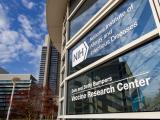Sep 26, 2007 (CIDRAP News) – An Institute of Medicine (IOM) committee that studied issues concerning personal protective equipment (PPE) for healthcare workers in an influenza pandemic is calling for renewed efforts to learn how influenza viruses spread, promote proper use of PPE, and improve the equipment itself.
The 12-member panel met in Washington, DC, in February and May to hear comments from stakeholders such as medical experts, manufacturers, and government agencies on masks, gowns, respirators, and related items. The group's mission was to recommend research directions, government agency roles, and policy changes, but not to issue guidelines about PPE use during a pandemic.
The group's 192-page peer-reviewed report was released Sep 18. It says the study was requested by the National Institute for Occupational Safety and Health (NIOSH) and the US Centers for Disease Control and Prevention (CDC).
More than 13 million US workers are employed in healthcare, according to the report, and public health officials worry that in a pandemic, medical staff won't report to work if they don't feel they're adequately protected.
Divided into three main parts, the report explores what is known and where research gaps exist concerning influenza transmission, use of PPE among healthcare workers, and PPE design, testing, and certification.
Flu transmission studies badly needed
Most studies on influenza transmission were conducted before 1970, and the report says more research should be done to build on earlier findings and apply new technologies, which include airborne-particle size analyzers and polymerase chain reaction (PCR) assays. Advances in fields such as aerobiology and mathematical modeling could also contribute to the study of seasonal and avian influenza, the group reported.
The group recommends that the US Department of Health and Human Services (HHS), in collaboration with other US and global partners, lead a focused research effort to better understand the transmission and prevention of seasonal and avian influenza. The global research network would:
- Identify and rank research questions, as well as suggest potential study designs
- Prioritize funding for short-term (1 to 3 years) laboratory and clinical studies on seasonal influenza transmission and prevention, focusing on the efficacy of different PPE items
- Develop evidence-based research protocols and implementation plans for clinical studies during an influenza pandemic
Strategies to promote routine PPE use
In analyzing PPE utilization by healthcare workers, the group noted that despite recommendations and high-risk settings, many employees don't wear the gear when they should. Healthcare institutions should do more to promote a "culture of safety" regarding PPE use by their employees, the report says.
"Employees should feel uncomfortable when not wearing PPE during appropriate situations, and supervisors should reinforce the importance of PPE and enforce policies so that noncompliance is the rare exception and not the rule," the authors state.
Recommendations for boosting PPE use in healthcare workers include:
- Emphasizing appropriate PPE use in patient care settings as well as in healthcare management, accreditation, and training
- Identifying and sharing best practices for improving PPE compliance; the authors recommend that the CDC and Agency for Healthcare Research and Quality (AHRQ) support and evaluate demonstration projects on improving PPE adherence
- Researching the human factors and behavioral issues related to PPE use, an effort that could be supported by agencies such as NIOSH, the National Institutes of Health (NIH), and AHRQ
Raising the bar for PPE design and testing
Several of the group's recommendations focus on improving PPE design, testing, and certification. More rigorous premarket testing is needed to ensure that PPE products work well in clinical settings, the authors assert. Evidence-based standards and comparison ratings should be developed for PPE items, they said.
In a letter prefacing the report, Lewis Goldfrank, MD, chair of the committee and chair of emergency medicine at New York University School of Medicine, wrote that the Food and Drug Administration's (FDA's) standards for evaluating and approving PPE are not as high as for the drugs or vaccines it regulates.
"It is our belief that healthcare workers will feel secure only when the PPE that they are asked to wear is as safe and as effective as the vaccines and medications they are asked to take," he wrote.
Several federal agencies have important roles in supporting effective use of PPE, and more coordinated efforts are needed to harmonize requirements and expedite all the development and implementation steps, the IOM committee says. "NIOSH, though the NPPTL [National Personal Protective Technology Laboratory], is well suited to ensuring this integrated approach," they note.
Though the committee wasn't asked to consider PPE for family members and others who will provide home care or want to protect themselves during a pandemic, the report points out some difficulties in that area. For example, new respirator designs that minimize or remove the need for fit testing would be beneficial, and PPE sold in retail stores is subject to limited regulation.
The committee asserts that addressing its recommendations in the next 6 to 12 months would significantly improve the nation's pandemic readiness.
See also:
Sep 18 IOM statement
IOM report on PPE for healthcare workers
http://www.nap.edu/catalog.php?record_id=11980
Mar 1 CIDRAP News story "IOM studying protective garb for health workers"




















